Growing Your Own Vegetables with Lorene Edwards Forkner
May 12th, 2009
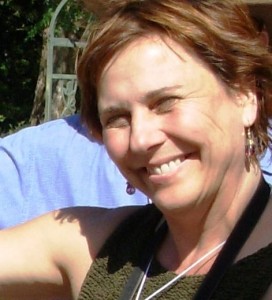
Lorene, visiting a waterwise garden in San Diego, 2007
I am so proud of my gal-pal Lorene Edwards Forkner and her latest book, Growing Your Own Vegetables (Sasquatch Books, 2009, $17.95).
An inspiring and essential compendium of vegetables and herbs to grow in your own backyard, GYOV is the first in Sasquatch’s series of single-topic references inspired by the late Carla Emery’s The Encyclopedia of Country Living.
If you came of age in the 1970s, you’ll remember this huge Yellow Pages-like tome. More than 600,000 copies have (and continue to be) sold over the years, even though Carla passed away in 2005.
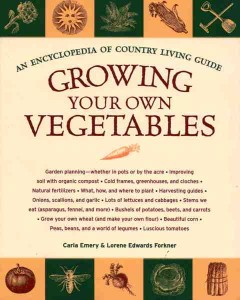 It’s a good thing that Lorene was a back-to-the-earth gal long before modern-day foodies who are just discovering the joys and benefits of tending to their own edible plants.
It’s a good thing that Lorene was a back-to-the-earth gal long before modern-day foodies who are just discovering the joys and benefits of tending to their own edible plants.
She writes confidently and lovingly about all the great veggie and herb crops that have grown in her potager over the years. In GYOV‘s 180 pages, Lorene’s lively, conversational tone makes the idea of planting and tending one’s own food sources sound easy and achievable. There’s no right or wrong here, just an enthusiasm that says, “Come on, you can do it, just try!”
Lorene hints at an early obsession with urban farming in her introduction to GYOV, in which she thanks her parents “who allowed me to dig up our backyard, plant corn, and walk away.”
That curious opening prompted me to request the “back story” when Lorene and I spoke by telephone last week. Here’s her true confession:
“It was the mid 1970s, I think I was in junior high school. One day, I tore up about one-third of our backyard and planted it with corn. Then I lost interest and walked away. Oh my goodness, it turned into the biggest mess! I was in so much trouble because what I created was everything that ran against my father’s neat-and-tidy instincts. It was total chaos. And that was truly my first garden.”
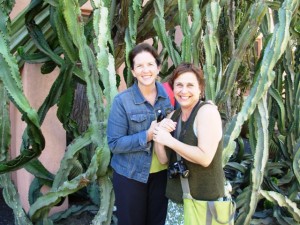
Lorene and me, visiting the famed Lotusland in Santa Barbara (2007)
Not much later Lorene went to college and married her high school sweetheart James (that’s where I met up with them in the late 70s-early 80s in Seattle).
After a successful career in art, garden design and nursery ownership, Lorene joined the writing profession in earnest several years ago. One day last spring, Lorene met with Gary Luke, Sasquatch’s editorial director. He showed up carrying the latest edition of ECL (which was about to celebrate its 35th anniversary of the first printing).
That’s when Lorene proclaimed: “I know this book. I bought it in college. I knew who Carla was and what she was about.”
With one Sasquatch title under her belt, the hilarious and irreverent Hortus Miscellaneous, Lorene agreed to tackle editing and rewriting the first two single-subject adaptations of ECL.
She’s an amazing writer, but this project called for more than good composition skills. It required a dose of literary anthropology and journalistic archaeology to dissect the 900-page, 3.5 pound title (yes, she weighed ECL’s 10th edition to verify this fact) and turn out a very readable, user-friendly Veggie Manual.
Join me in a conversation with Lorene. I’m sure you’ll be inspired to try growing something new and delicious in your own backyard:
What’s different about Carla Emery of the 1970s and Lorene Edwards Forkner of 2009?
In the mid-70s, there was a lot of fear. People were dropping out and removing themselves from what they perceived to be the failure of a political system. Carla and her readers wanted independence, self-sufficiency and detachment. Today, we’re witnessing a motivational shift. Like Carla, today people are looking to take care of their families but they are also eager to participate as part of a community and come together to join in the process of growing food – healthy, clean and local food.
The timing is pretty perfect on this book, isn’t it?
We’ve hit a vegetable zeitgeist. Everyone from the First Lady to young, twentysomethings are saying, ‘I want to grow vegetables,” even if all they have is a tiny balcony or a few containers. Today’s foodie and edible gardener has a far more sophisticated palate. Rather than sustenance planting, we want to know how to get those amazing bitter greens or fava beans that are only available at restaurants for like 15 minutes each spring. Our tastes have expanded so much. I want people to “Eat the Seasons” rather than just grow carrots year in and year out.
Do you feel like you’re channeling Carla Emery, though?
I have a little bit of Carla in me. She wanted to generously share what she was learning. She wanted to codify and list and make all this information available to other people. She was nothing if not a list-maker and compiler. So I’ve tried to keep her flavor and make this a bit of homage to Carla.
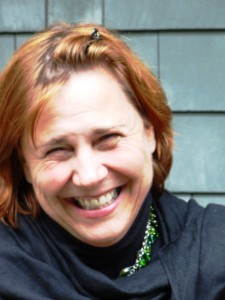
Lorene, at my "Good-bye-Seattle" garden gals party in July 2006
Can you share an example?
Well, I wanted to include the part about choosing between power tools or draft horses to till your soil. Not a question many of us wrestle with these days, but a “detail” Carla wouldn’t think to omit. The only difference is that Carla also wrote about how to raise the food to feed the draft horses and care for their veterinary needs.
That’s a little extreme. How about another Carla-ism that you included?
Carla had a passionate curiosity. That’s the part where I most connect with her. Carla gardened in Idaho. I garden in Washington. She had no earthly reason to include Taro and Yams in her book, but she did. And like her, I’m all about exhaustive research. Taro has to come from somewhere; generally it gets left out of so many vegetable books. It’s about “inclusiveness.” I look at it as a form of wonderment. It feels really good to say, “No, this isn’t just a book about the Northwest vegetable garden.”
How is this book unique in the world of so many vegetable gardening books?
I really liked the way Carla organized edibles – by plant parts. I hadn’t seen that done before and it’s brilliant. If you’re looking to plant a salad green, you automatically think “lettuce,” but this format introduces an entire spectrum of Leaves, opening up your table and menus to so much more. You get braising greens like kale and cabbage. You can paint the whole year in leaves. Other chapters are Stems & Flowers, and Roots — that’s a huge category.
What did you learn that surprised your food-growing assumptions?
Grains and Grasses. The whole notion of putting in a small crop of grain in the backyard is an exercise most of us would do well to take on. Here is a food that is central to life on our planet. Carla was very good about making those big reaches. The Grass family supports all animal life on earth. But hardly anybody grows it. So last fall after turning in my finished manuscript I planted winter wheat in a 2-by-4 foot wood box on my front deck. It is so darned cute and it’s just beginning to “head.” By mid summer, I’ll be lounging beside my own amber waves of grain. I’m as excited as a little kid with a bean in a Dixie Cup!
What will you do after you harvest it?
I don’t really know. I’ll probably bind the grain together into a sheaf and hang it on my front porch. For me, it’s more about following a process; and I love the crossover from vegetable gardening to garden design. It’s bountiful and beautiful.
So what’s next, Lorene?
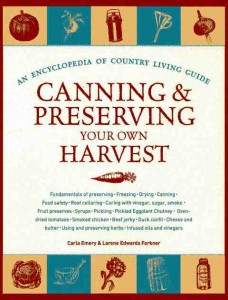 As soon as I finished the vegetable book last summer, I started working on the next title in the ECL series: Canning & Preserving Your Own Harvest (out in August 2009).
As soon as I finished the vegetable book last summer, I started working on the next title in the ECL series: Canning & Preserving Your Own Harvest (out in August 2009).
While I was writing it, my family ate jam for dinner – or not at all.
This book is all about ways to preserve food. Carla’s approach was very focused on putting up staples to get one through until the next growing season.
I tried to expand the topic to include those preserves that can be characterized as foods of celebration.
Drying, canning and freezing are covered, of course, but also esoteric ways to preserve food (with salt, vinegar, alcohol, sugar and other methods).
For example, you can eat fresh raspberries in July, but in January, you can have raspberry preserves, where the berries have been eleveated into something that’s actually party food.
 What are you writing these days?
What are you writing these days?
These days I’m having a ball exploring the “resourceful life” and carrying on a lively discussion about all things gardening, food, travel, and a certain amount of navel gazing on my blog at “. . . this is me, Planted at home.”
After so many years in retail gardening, it’s good to be home.
Thank you, Lorene. It’s good — and inspiring — to have you home and to follow your adventures.









May 12th, 2009 at 7:53 pm
Ah Deb,
Thank you so very much. My voice is stronger for your constant good will and support. “It’s all Good!”
oxoxo Lorene
May 12th, 2009 at 8:37 pm
[…] can read the whole lovely, gushing review here (Growing Your Own Vegetables with Lorene Edwards Forkner) along with a Q&A interview Debra & […]
March 8th, 2012 at 10:50 am
Ulrike iPad Sara…
[…]Debra Prinzing » Blog Archive » Growing Your Own Vegetables with Lorene Edwards Forkner[…]…